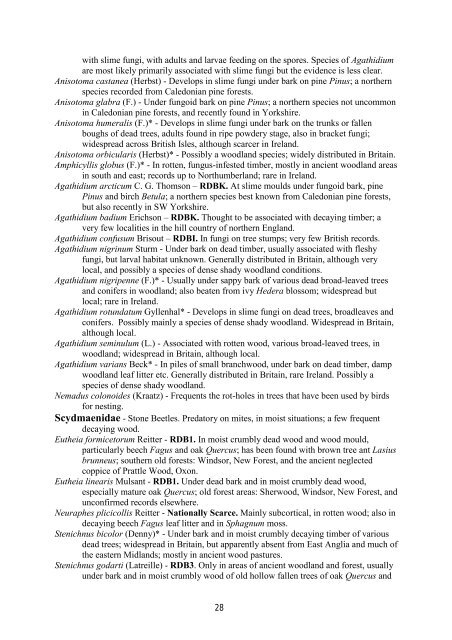Crustacea: Copepoda - Cerambycoidea.com
Crustacea: Copepoda - Cerambycoidea.com
Crustacea: Copepoda - Cerambycoidea.com
You also want an ePaper? Increase the reach of your titles
YUMPU automatically turns print PDFs into web optimized ePapers that Google loves.
with slime fungi, with adults and larvae feeding on the spores. Species of Agathidium<br />
are most likely primarily associated with slime fungi but the evidence is less clear.<br />
Anisotoma castanea (Herbst) - Develops in slime fungi under bark on pine Pinus; a northern<br />
species recorded from Caledonian pine forests.<br />
Anisotoma glabra (F.) - Under fungoid bark on pine Pinus; a northern species not un<strong>com</strong>mon<br />
in Caledonian pine forests, and recently found in Yorkshire.<br />
Anisotoma humeralis (F.)* - Develops in slime fungi under bark on the trunks or fallen<br />
boughs of dead trees, adults found in ripe powdery stage, also in bracket fungi;<br />
widespread across British Isles, although scarcer in Ireland.<br />
Anisotoma orbicularis (Herbst)* - Possibly a woodland species; widely distributed in Britain.<br />
Amphicyllis globus (F.)* - In rotten, fungus-infested timber, mostly in ancient woodland areas<br />
in south and east; records up to Northumberland; rare in Ireland.<br />
Agathidium arcticum C. G. Thomson – RDBK. At slime moulds under fungoid bark, pine<br />
Pinus and birch Betula; a northern species best known from Caledonian pine forests,<br />
but also recently in SW Yorkshire.<br />
Agathidium badium Erichson – RDBK. Thought to be associated with decaying timber; a<br />
very few localities in the hill country of northern England.<br />
Agathidium confusum Brisout – RDBI. In fungi on tree stumps; very few British records.<br />
Agathidium nigrinum Sturm - Under bark on dead timber, usually associated with fleshy<br />
fungi, but larval habitat unknown. Generally distributed in Britain, although very<br />
local, and possibly a species of dense shady woodland conditions.<br />
Agathidium nigripenne (F.)* - Usually under sappy bark of various dead broad-leaved trees<br />
and conifers in woodland; also beaten from ivy Hedera blossom; widespread but<br />
local; rare in Ireland.<br />
Agathidium rotundatum Gyllenhal* - Develops in slime fungi on dead trees, broadleaves and<br />
conifers. Possibly mainly a species of dense shady woodland. Widespread in Britain,<br />
although local.<br />
Agathidium seminulum (L.) - Associated with rotten wood, various broad-leaved trees, in<br />
woodland; widespread in Britain, although local.<br />
Agathidium varians Beck* - In piles of small branchwood, under bark on dead timber, damp<br />
woodland leaf litter etc. Generally distributed in Britain, rare Ireland. Possibly a<br />
species of dense shady woodland.<br />
Nemadus colonoides (Kraatz) - Frequents the rot-holes in trees that have been used by birds<br />
for nesting.<br />
Scydmaenidae - Stone Beetles. Predatory on mites, in moist situations; a few frequent<br />
decaying wood.<br />
Eutheia formicetorum Reitter - RDB1. In moist crumbly dead wood and wood mould,<br />
particularly beech Fagus and oak Quercus; has been found with brown tree ant Lasius<br />
brunneus; southern old forests: Windsor, New Forest, and the ancient neglected<br />
coppice of Prattle Wood, Oxon.<br />
Eutheia linearis Mulsant - RDB1. Under dead bark and in moist crumbly dead wood,<br />
especially mature oak Quercus; old forest areas: Sherwood, Windsor, New Forest, and<br />
unconfirmed records elsewhere.<br />
Neuraphes plicicollis Reitter - Nationally Scarce. Mainly subcortical, in rotten wood; also in<br />
decaying beech Fagus leaf litter and in Sphagnum moss.<br />
Stenichnus bicolor (Denny)* - Under bark and in moist crumbly decaying timber of various<br />
dead trees; widespread in Britain, but apparently absent from East Anglia and much of<br />
the eastern Midlands; mostly in ancient wood pastures.<br />
Stenichnus godarti (Latreille) - RDB3. Only in areas of ancient woodland and forest, usually<br />
under bark and in moist crumbly wood of old hollow fallen trees of oak Quercus and<br />
28

















